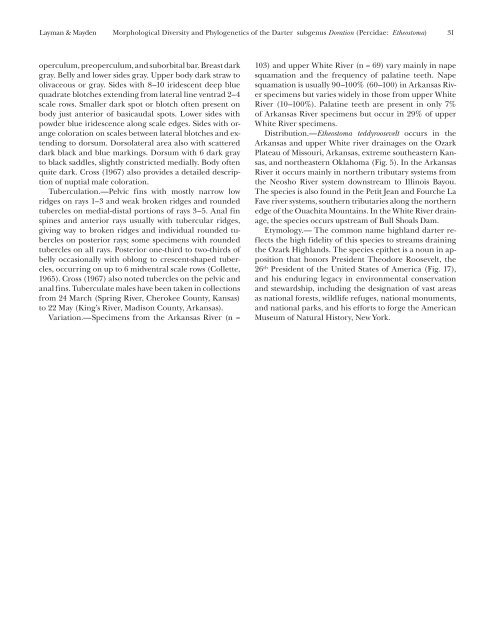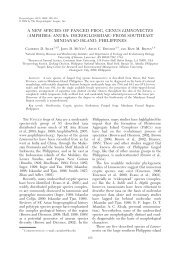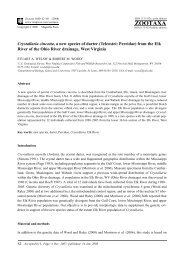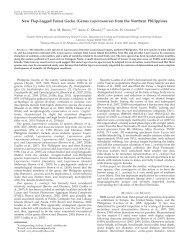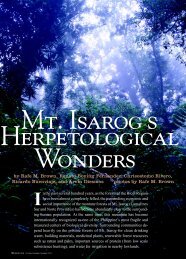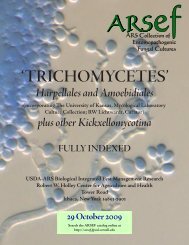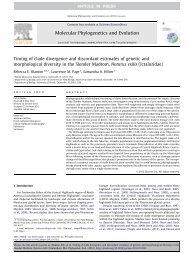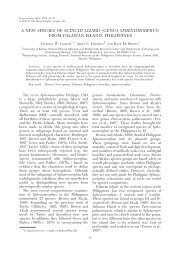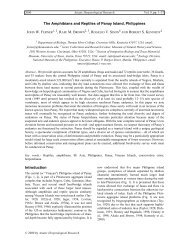(Percidae: Etheostoma), with Descriptions of Five New Species
(Percidae: Etheostoma), with Descriptions of Five New Species
(Percidae: Etheostoma), with Descriptions of Five New Species
- No tags were found...
Create successful ePaper yourself
Turn your PDF publications into a flip-book with our unique Google optimized e-Paper software.
Layman & Mayden Morphological Diversity and Phylogenetics <strong>of</strong> the Darter subgenus Doration (<strong>Percidae</strong>: <strong>Etheostoma</strong>) 31operculum, preoperculum, and suborbital bar. Breast darkgray. Belly and lower sides gray. Upper body dark straw toolivaceous or gray. Sides <strong>with</strong> 8–10 iridescent deep bluequadrate blotches extending from lateral line ventrad 2–4scale rows. Smaller dark spot or blotch <strong>of</strong>ten present onbody just anterior <strong>of</strong> basicaudal spots. Lower sides <strong>with</strong>powder blue iridescence along scale edges. Sides <strong>with</strong> orangecoloration on scales between lateral blotches and extendingto dorsum. Dorsolateral area also <strong>with</strong> scattereddark black and blue markings. Dorsum <strong>with</strong> 6 dark grayto black saddles, slightly constricted medially. Body <strong>of</strong>tenquite dark. Cross (1967) also provides a detailed description<strong>of</strong> nuptial male coloration.Tuberculation.—Pelvic fins <strong>with</strong> mostly narrow lowridges on rays 1–3 and weak broken ridges and roundedtubercles on medial-distal portions <strong>of</strong> rays 3–5. Anal finspines and anterior rays usually <strong>with</strong> tubercular ridges,giving way to broken ridges and individual rounded tubercleson posterior rays; some specimens <strong>with</strong> roundedtubercles on all rays. Posterior one-third to two-thirds <strong>of</strong>belly occasionally <strong>with</strong> oblong to crescent-shaped tubercles,occurring on up to 6 midventral scale rows (Collette,1965). Cross (1967) also noted tubercles on the pelvic andanal fins. Tuberculate males have been taken in collectionsfrom 24 March (Spring River, Cherokee County, Kansas)to 22 May (King’s River, Madison County, Arkansas).Variation.—Specimens from the Arkansas River (n =103) and upper White River (n = 69) vary mainly in napesquamation and the frequency <strong>of</strong> palatine teeth. Napesquamation is usually 90–100% (60–100) in Arkansas Riverspecimens but varies widely in those from upper WhiteRiver (10–100%). Palatine teeth are present in only 7%<strong>of</strong> Arkansas River specimens but occur in 29% <strong>of</strong> upperWhite River specimens.Distribution.—<strong>Etheostoma</strong> teddyroosevelt occurs in theArkansas and upper White river drainages on the OzarkPlateau <strong>of</strong> Missouri, Arkansas, extreme southeastern Kansas,and northeastern Oklahoma (Fig. 5). In the ArkansasRiver it occurs mainly in northern tributary systems fromthe Neosho River system downstream to Illinois Bayou.The species is also found in the Petit Jean and Fourche LaFave river systems, southern tributaries along the northernedge <strong>of</strong> the Ouachita Mountains. In the White River drainage,the species occurs upstream <strong>of</strong> Bull Shoals Dam.Etymology.— The common name highland darter reflectsthe high fidelity <strong>of</strong> this species to streams drainingthe Ozark Highlands. The species epithet is a noun in appositionthat honors President Theodore Roosevelt, the26 th President <strong>of</strong> the United States <strong>of</strong> America (Fig. 17),and his enduring legacy in environmental conservationand stewardship, including the designation <strong>of</strong> vast areasas national forests, wildlife refuges, national monuments,and national parks, and his efforts to forge the AmericanMuseum <strong>of</strong> Natural History, <strong>New</strong> York.


